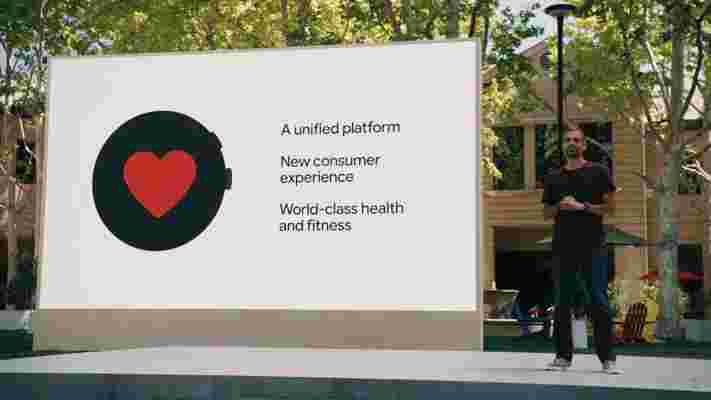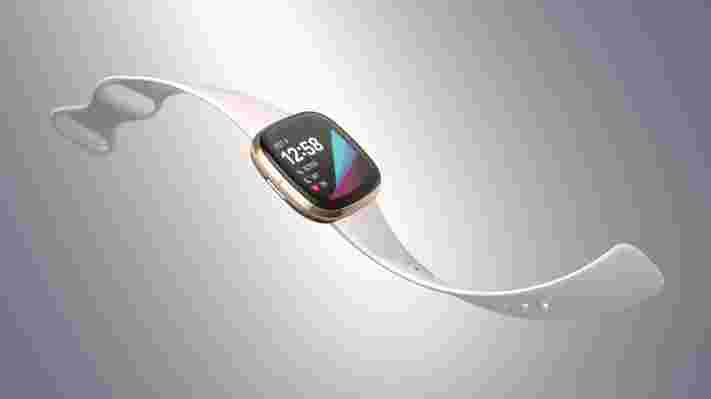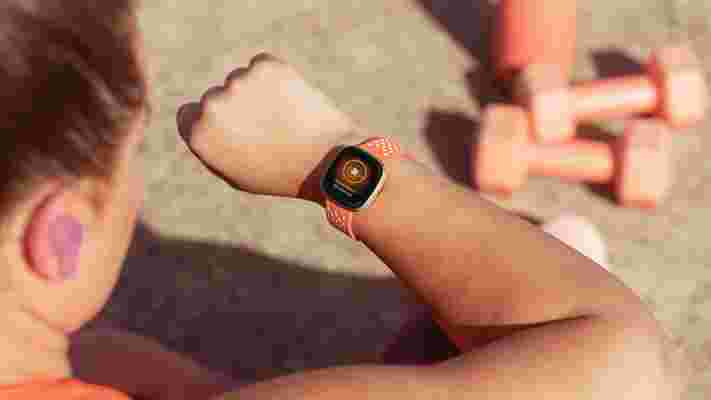The Fitbit Charge 4, when it arrives, will be Fitbit 's next top-end fitness tracker . It's not been announced yet, but we can make some educated predictions about which features it'll bring to our wrists when it eventually arrives.
The arrival of the Fitbit Charge 5 in September 2021 gave us some hints about where the company might be taking its watches over the coming years, but now that Google owns Fitbit, it's possible that the Charge 4 could be something different entirely.
We'll keep this guide updated with new news and rumors as soon as they arrive, so keep it bookmarked and check back regularly for the latest info.
Cut to the chase
Fitbit Versa 4 news and leaks
News about the Fitbit Versa 4 has yet to start filtering through, but the company has made some interesting announcements recently that have us excited about what the next-generation smartwatch could be.
In January 2021, Google finalized its acquisition of Fitbit , despite concerns from industry watchdogs about the two companies' potential to stifle competition. Things then went quiet for a few months, but at the 2021 Google IO event in May, we learned that Fitbit is working on a premium fitness tracker running Google's smartwatch operating system, Wear OS .
That's big news, and could mean that the Fitbit Versa 4 is drastically different to previous watches in the series. Until now, all Fitbit wearables have used the company's own proprietary operating system, Fitbit OS. As you'd expect, this operating system is focused almost entirely on fitness tracking, and only supports a small handful of third-party apps (most of which are relatively simple workout trackers and timers).

A Fitbit running Wear OS would be capable of so much more. Not only would it be able to track steps, activities, heart rate, and all the other metrics you'd expect from a typical fitness tracker, it would also integrate with all of Google's other tools (Gmail, Google Maps, Google Pay etc), and give you access to a huge array of music streaming, social media, news, health and organization apps from Google Play.
There's no guarantee that this premium Fitbit will be the Versa 4, but it seems more likely than it being the Google Pixel Watch , which is said to be in development by a completely separate team.
What we're expecting
Fitbit devices typically follow a two-year release cycle. The Fitbit Versa 3 was released in August 2020, so we're therefore hoping to get our first glimpse of the Versa 4 in August 2022. More recently, mentions of a device that could be the Versa 4 have popped up in Fitbit's Android app , suggesting an imminent launch.
The company usually keeps its cards close to its chest, and we rarely get an early peek at watches before they're released, but it's still possible. Images of the Fitbit Luxe leaked a few days ahead of its official launch, it's not beyond the realms of possibility that we might get an early peek.
It's also possible that we may get an early insight into the Versa 4's specifications through an accidental leak In 2021 a 3D render appeared online, reported to be a new Fitbit device codenamed 'Morgan' . This proved to be our first look at the Fitbit Charge 5 .
The same source may release a similar image of the Versa 4 nearer its launch date. We'll be keeping our ears open and eyes peeled.
Design
Fitbit's latest watches (including the Charge 5 , Sense , Versa 3 , Inspire 2 , and Luxe ) all share a similar style, with rounded edges and smooth lines. This is a result of what Fitbit calls its Biologic Industrial Design Language, which is designed to work with the shape of the human body, making devices that are comfortable and ergonomic.
Colors are muted (shades of black, cream, soft pink and midnight blue dominate the palette) and metal cases have a brushed finish. It's a style the company seems committed to, so we're expecting the Versa 4 to stick with the same look.

We're also expecting it to have a familiar shape; watches in the Versa series have always had square faces with rounded edges, so we're not anticipating a switch to round or rectangular face.
We're also expecting it to stick with AMOLED screen technology, though we'd like to see a boost in resolution - particularly if the Versa 4 turns out to be Fitbit's first WEar OS smartwatch. The Versa 3 has a resolution of 336 x 336 pixels, but a boost to 454 x 454 (the same as the superb TicWatch Pro 3 ) would be a real boon for apps like Gmail and Google Maps.
Fitness features
The Fitbit Versa 3 does a great job of bridging the gap between fitness trackers and smartwatches, but it's not without its flaws. Almost all of these would be solved automatically if the Versa 4 turns out to be the rumored premium Wear OS device (with access to all the accompanying apps) but even if it's another FitbitOS watch, there are some tweaks that we'd like to see.
One thing we're definitely expecting is on-board GPS for tracking walks, runs, and bike rides. This is something that's been part of the Versa line for some time now, and it allows the watch to accurately track your speed and distance without the need to carry your smartphone.
On the subject of phone-free use, we'd appreciate more offline music options. While the Versa 3 supports Spotify and Pandora, you can only add playlists for offline listening via Deezer . We're not going to hold out breath, though. When the Fitbit Charge 5 arrived on the scene, it packed lots of new health sensors into a tiny package, but lost the music streaming capabilities of the Charge 4.

We'd also like to see the Fitbit Versa 4 borrow a few features from the Fitbit Sense. When the Fitbit Charge 5 arrived, it brought with it the Sense's stress monitoring EDA (electrodermal activity) sensor, plus its ECG (electrocardiogram) sensor to check for signs of atrial fibrillation. If these can be packed into a device as compact as the Charge 5, we'd be surprised if they weren't integrated into the Versa 4.
Improved battery capacity would also be a win. The Versa 3 can run for up to six days between charges (an improvement from three to four days for the Versa 2) so ideally we'd like to see the Versa 4 last a full week. Battery life drops significantly when using on-board GPS, and the addition of offline music storage and playback would cut it further, so a larger capacity may be a necessity.
A higher resolution display would also be a bonus. An upgraded screen would allow Fitbit to follow in the footsteps of Garmin, which has introduced on-screen yoga and Pilates workouts to many of its latest devices so you can follow along without using your phone. It would be a natural addition for Fitbit devices, and could be made available as a bonus for Fitbit Premium subscribers.
About TechRadar
The world of technology has never been more exciting -- and TechRadar helps up to 70 million people around the globe find the tech they love every month. Our world-class experts live and breathe the latest technology, and like a trusted friend or advisor, we won't talk down to you or baffle you with jargon, instead offering clear, unbiased, useful advice, as well as tips, tricks, and secrets culled from our rigorous in-depth testing.
Our mission is simple: to be the source for tech-buying advice, offering everything you need to buy and enjoy the tech you love.
We'll tell you what the greatest gear is, where you can get the best deals and then the most fantastic things you can do with them. Why do we do it? Because this matters to us. We get up in the morning knowing that there are people out there worried about spending their hard-earned money on a piece of tech that's central to their lives.
Getting the right phone is crucial - it's with you all the time, isn't it? Finding the right TV can radically alter the success of family night. Buying the right laptop can save stress and back pain. Consider TechRadar your helpful voice, not just because we love pixels, gigahertz and heart-rate monitoring, but because we're here to help.
But technology is moving faster and faster, and we know our tech lives go beyond just buying the right laptop. That's why the TechRadar family has grown:
Not only does TechRadar help you find the tech you'll love, we're passionate about telling you how to use it, how to make it work with other vital parts of your life and even what apps, games and media you should think about downloading, playing and watching.
We know that your relationship with tech doesn't end when you've clicked checkout, either. We continue to test, evaluate and monitor the updates and changes that now come regularly from the big brands and can radically alter your smartwatch, headphones or even coffee machine.
We'll also tell you about all of the big events and critical happenings from the world of tech. From entertainment to EVs, smartphones to smart bulbs and Windows to wearables, we're here to be your trusted friend in our complicated tech lives.
TechRadar was launched in 2007 with a team based mostly in the UK, with a couple of overseas writers to spot breaking stories while we slept. The site quickly grew to become the UK's biggest consumer technology site, a position it still holds to this day.
It soon became time to go global, so we expanded to the US in April 2012 - with a dedicated American team hired at the time in Future PLC's San Francisco and New York City offices.
In October 2012, TechRadar launched in Australia, with the site again leveraging Future PLC's existing presence in Sydney to hire a local team that has grown to make TechRadar one of Australia’s leading tech sites.
We began the TechRadar Awards program in 2015, and are proud to recognise and award the companies we think are deserving of your applause each and every year.

TechRadar has continued to rapidly expand its global reach, and the site is now licensed in over 10 additional countries around the world, and available in 10 different languages. The first of these licencees, TechRadar India, launched in 2014, and we continue to expand into different locations where we can make a difference and help our audience.
We now reach up to 70 million readers a month in the US, UK, Canada, Australia, India and beyond - we're honored to have each and every set of eyeballs and continue to focus on what matters to all of them.
Whatever time of day it is, there's someone, somewhere in the world, online and working on TechRadar to bring you the best in tech news, reviews, features and buying guides.

The team at TechRadar has been carefully selected to only include those that love the world of technology. We don't just want to talk about it, we want to try it, to live it, to breathe in everything about it so we can give our readers the inside scoop on what actually matters.
This means that we go the extra mile when it comes to telling you what's happening behind the scenes in our testing. We've published hundreds of articles from the perspective of our writers, telling you when something is great, the technology we can now no longer live without... and the stuff you simply have to avoid.

We'll run 31 miles with four watches strapped on to see if the numbers really do add up. We'll plug ourselves into motion capture to see how games are really made . We constantly talk to the biggest names in tech to find out what's really going on.
And we do it because we're just like you: gadget fans who just want to know what's going on and getting the best out of their tech.
We pride ourselves on our independence and our rigorous review-testing process, offering up long-term attention to the products we review and making sure our reviews are constantly updated and maintained - regardless of when a device was released, if you can still buy it, it's on our radar.
We have assembled a global team of some of the finest technology journalists on the planet, who are not only experts in their field, but are the same people we write our reviews for: those who want to know about and use the latest and best technology.
This is our promise to you:
Our five star scoring system
We use a familiar five-star scoring system, in order to keep things recognizable and simple: the more stars, the better.
Although we only offer a single star rating, we scrutinize a product on a number of criteria, depending on the specific attributes of a product type.
What is a hands-on review?
Hands-on reviews are a journalist's first impressions of a piece of kit based on spending some time with it. It may be just a few moments, or a few hours.
The important thing is we have been able to play with it ourselves and can give you some sense of what it's like to use, even if it's only an embryonic view.
Get in touch
Email : news@techradarom
New York City, USA Address: Full 7th Floor, 130 West 42nd Street, New York, NY 10036 Telephone: +1 212 378 0448
London, UK Address: 121 - 141 Westbourne Terrace, Paddington, London W2 6JR Telephone: +44 (0)20 7042 4000
Bath, UK Address: Quay House, The Ambury, Bath BA1 1UA Telephone: +44 (0)1225 442244
Sydney, Australia Address: Level 10, 89 York Street, Sydney 2000 Telephone: (02) 9955 2677
Want to advertise with us? Read more about advertising opportunities .
Follow TechRadar on social
It's not just our website that we use to connect with our readers - we publish all our great analysis, insight and up-to-the-minute reviews to our millions of fans across multiple platforms.
Editorial independence
No outside party determines the products we cover, review and place in our buying guides. The content of our editorial articles remains entirely independent. Nothing that has a star rating has been paid for.
Our editorial independence is backed by the weight of one of the world's largest technology publishers, Future PLC , which means we can tell you what we think of a product, without fear or favor.
We sometimes take trips and hospitality to attend shows and see products, in order to bring you instant coverage of the latest products. We never let it affect our judgement or response to a product, but it can sometimes be the only way we are able to bring you coverage of a new product, device or service.
While we purchase some products we review, we often use company's loan programs. Again, we're not going to pull any punches if the device just isn't good enough for our readers - we always seek to make sure that the review unit we get is representative of what you'll be able to buy, but we're here to help you and this is often the only way to get our hands on something before it goes on sale.
We always return products at the request of the brand or at the end of the agreed loan period.
We always aim to provide unbiased editorial created by our journalists and writers. We also need to pay our teams and website costs so we make money in a number of ways. We sometimes use affiliate links to products and services on retailer sites for which we can receive compensation if you click on those links or make purchases through them. From time to time we also publish advertorials (paid-for editorial content) and sponsored content on the site. When this is the case the content is clearly marked as sponsored or promoted, so you’ll always know which content is editorial and which is not. Future PLC is our parent company and has an in-depth terms and conditions page with a lot more information that you can read right here .
Certified and Regulated
TechRadar is a member of the Independent Press Standards Organisation (which regulates the UK's magazine and newspaper industry). We abide by the Editors' Code of Practice and are committed to upholding the highest standards of journalism.
If you think that we have not met those standards and want to make a complaint please contact news@techradarom . If we are unable to resolve your complaint, or if you would like more information about IPSO or the Editors' Code, contact IPSO on 0300 123 2220 or visit www.ipsoo.uk .
TechRadar has been rated GREEN for its credibility and trustworthiness by NewsGuard , a global service that rates news sources for their journalistic standards.
Join the TechRadar team
Do you dream of working on TechRadar? If so, we'd love to have you, and from time-to-time we will advertise vacancies. Please check the Future PLC careers page to see if there are currently any open vacancies.
If you're a freelancer who has a fantastic pitch you'd love to share with us, then please email news@techradarom . We're committed to hearing and developing talented voices from any background or education, encourage diversity and strive to amplify the voices of minorities, those in the LGBTQ+ community and people with disabilities.
TechRadar is part of Future PLC. We are both fiercely committed to protecting your privacy. Please have a look at our in-depth privacy policy to find out more.
Polestar 5 is being developed with a supercar-grade EV platform
Polestar announced development of a new bonded aluminum platform, along with a new car that will utilize it as it looks to the next generation of its electric vehicles.
Polestar used to be the rowdy performance arm of Volvo, but the two names split a few years ago as Polestar began focusing on premium EVs. The offshoot automaker currently has two vehicles in production, with the Polestar 2 as its current flagship.
Polestar developed the new aluminum platform in-house, using its team of more than 280 engineers in Coventry, England.
Bonded aluminum construction creates a structure that is lightweight but rigid, though as Polestar admits, it's a labor-intensive and temperamental material to use in mass production.
The automaker also developed a new manufacturing process that builds the body and platform together, which creates a combination that weighs less than cars in smaller segments. The upside of all that work is that the Polestar 5 targets a level of torsional rigidity not often seen outside of supercars and dedicated sports cars.
A performance 4-door fully electric GT

The new platform will underpin the upcoming Polestar 5 - based on the Precept concept vehicle - which will be a performance 4-door fully electric GT that's likely to go head-to-head with the Audi etron GT and Porsche Taycan when it arrives in 2024.
The company believes its new platform will accelerate the pace of new vehicle development and allow it to push vehicles to market more quickly.
"We knew we wanted this car to be lightweight, we knew we wanted high quality and we knew we wanted it quickly," noted Pete Allan, Polestar's Head of UK R&D.
The concept debuted in 2020 as a sleek four-door grand touring car. The Polestar 5 will come in 2024 with a similar design and proportions.
As Polestar notes, the new dedicated EV platform allows it to create a vehicle with better rigidity and less weight overall, as well as "class-leading dynamics, rigidity, and safety features."
An EV-only platform also enables better battery placement, as the Polestar 2 shares a platform with the Volvo XC40 and C40. The architecture was designed for vehicles with internal combustion engines, so the addition of a large lithium-ion battery pack cuts into passenger and cargo space.